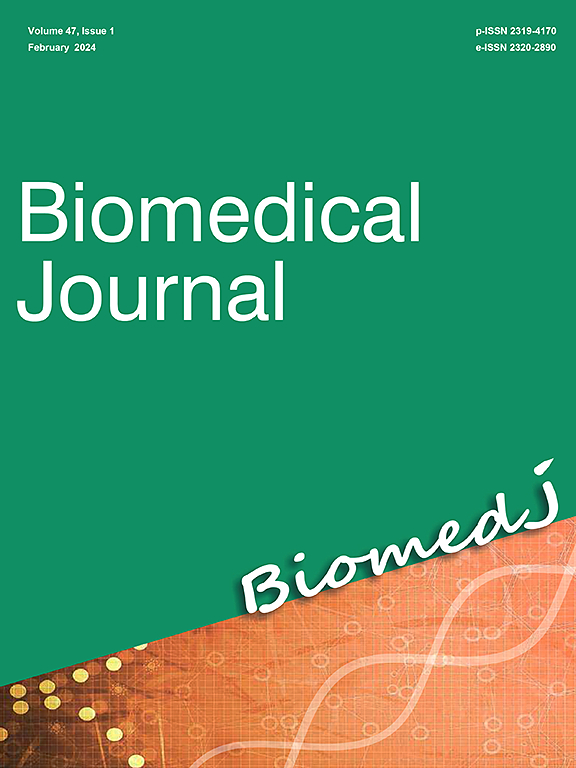多西环素联合阿苯达唑疗法可缓解C57BL/6和BALB/c小鼠感染坎顿氏安氏梭菌后的神经功能损伤。
IF 4.4
3区 医学
Q2 BIOCHEMISTRY & MOLECULAR BIOLOGY
引用次数: 0
摘要
研究了阿苯达唑联合强力霉素对广州管圆线虫感染小鼠早期和晚期治疗的影响。材料与方法将sc57bl /6和BALB/c小鼠分为5组:(i)未感染、(ii)广东棘球螨感染、(iii)感染+ 10mg /kg阿苯达唑、(iv)感染+ 25mg /kg强力霉素、(v)感染+ 10mg /kg阿苯达唑+ 25mg /kg强力霉素。我们对广东弧菌感染的C57BL/6和BALB/c小鼠在感染后7天开始的早期治疗(dpi)和晚期治疗(14 dpi)给予药物治疗。为了评估这些处理对C57BL/6小鼠空间学习和记忆能力的影响,我们采用Morris水迷宫测试和旋转杆测试来评估C57BL/6小鼠的运动协调和平衡能力。此外,我们用Western blot方法检测了这些小鼠大脑中细胞因子IL-33和GFAP的表达。结果本研究发现,广东棘球绦虫感染可引起C57BL/6小鼠广泛的脑血管线虫病。这种情况显著影响了他们的空间学习和记忆能力(通过Morris水迷宫测试评估),以及他们的运动协调能力(通过旋转杆测试评估)。早期阿苯达唑治疗导致良好的恢复结果。C57BL/6和BALB/c小鼠联合治疗后均表达IL-33和GFAP。小鼠IL-33和GFAP表达水平和模式的差异可能受到免疫系统内促炎和抗炎信号平衡的影响。结论在C57BL/6和BALB/c感染早期,采用驱虫药和抗生素联合治疗,可使脑内寄生虫死亡,减轻后续的神经功能损害,减缓脑损伤和神经行为损害。本研究提示了一种更有效和新颖的脑病变治疗方法和药物递送方法,可以减少血管圆线虫病患者的神经损伤。本文章由计算机程序翻译,如有差异,请以英文原文为准。
Doxycycline cotherapy with albendazole relieves neural function damage in C57BL/6 and BALB/c mice infected with Angiostrongylus cantonensis
Background
We investigated the effects of combination therapy albendazole and doxycycline in Angiostrongylus cantonensis-infected mice during early and late treatment.
Materials and methods
C57BL/6 and BALB/c mice were divided into five groups: (i) uninfected, (ii) infected with A. cantonensis, (iii) infected + 10 mg/kg albendazole, (iv) infected + 25 mg/kg doxycycline, and (v) infected + 10 mg/kg albendazole + 25 mg/kg doxycycline. We administered drugs in both early treatments started at 7-day post infections (dpi) and late treatments (14 dpi) to A. cantonensis-infected C57BL/6 and BALB/c mice. To assess the impact of these treatments, we employed the Morris water maze test to evaluate spatial learning and memory abilities, and the rotarod test to measure motor coordination and balance in C57BL/6 mice. Additionally, we monitored the expression of the cytokine IL-33 and GFAP in the brain of these mice using Western blot analysis.
Results
In this study, A. cantonensis infection was observed to cause extensive cerebral angiostrongyliasis in C57BL/6 mice. This condition significantly affected their spatial learning and memory abilities, as assessed by the Morris water maze test, as well as their motor coordination, which was evaluated using the rotarod test. Early treatment with albendazole led to favorable recovery outcomes. Both C57BL/6 and BALB/c mice express IL-33 and GFAP after co-therapy. The differences of levels and patterns of IL-33 and GFAP expression in mice may be influenced by the balance between pro-inflammatory and anti-inflammatory signals within the immune system.
Conclusions
Combination therapy with anthelmintics and antibiotics in the early stage of A. cantonensis infection, in C57BL/6 and BALB/c mice resulted in the death of parasites in the brain and reduced the subsequent neural function damage and slowed brain damage and neurobehavior impairment. This study suggests a more effective and novel treatment, and drug delivery method for brain lesions that can decrease the neurological damage of angiostrongyliasis patients.
求助全文
通过发布文献求助,成功后即可免费获取论文全文。
去求助
来源期刊

Biomedical Journal
Medicine-General Medicine
CiteScore
11.60
自引率
1.80%
发文量
128
审稿时长
42 days
期刊介绍:
Biomedical Journal publishes 6 peer-reviewed issues per year in all fields of clinical and biomedical sciences for an internationally diverse authorship. Unlike most open access journals, which are free to readers but not authors, Biomedical Journal does not charge for subscription, submission, processing or publication of manuscripts, nor for color reproduction of photographs.
Clinical studies, accounts of clinical trials, biomarker studies, and characterization of human pathogens are within the scope of the journal, as well as basic studies in model species such as Escherichia coli, Caenorhabditis elegans, Drosophila melanogaster, and Mus musculus revealing the function of molecules, cells, and tissues relevant for human health. However, articles on other species can be published if they contribute to our understanding of basic mechanisms of biology.
A highly-cited international editorial board assures timely publication of manuscripts. Reviews on recent progress in biomedical sciences are commissioned by the editors.
 求助内容:
求助内容: 应助结果提醒方式:
应助结果提醒方式:


